When you create your bot, it’s important to consider its purpose and persona, as well as the flow of its chats with customers. These are essential elements of conversation design. 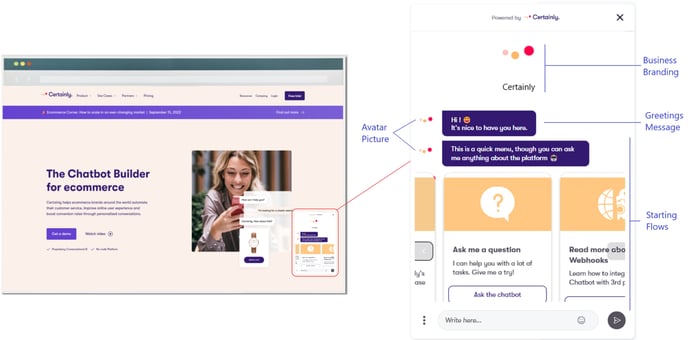
In this article, we’ll share some best practices to help you enhance the bot-user experiences, addressing how to:
- Establish the basics before building
- Create a chatbot persona
- Prioritize the readability of your messaging
- Ensure intuitive navigation
- Evaluate and improve performance
Establish the basics before building
Determine how and where you’ll use your bot. This helps ensure it provides interest and value for customers, supports your company’s goals, and works within your existing infrastructure.
Understand your audience
Which users are you targeting? Do you know their needs and pain points, and what you can do to address those? What is their typical user journey? How do they prefer to communicate?
Answering these questions will help you lay the groundwork for your chatbot. This information will help you tackle several of the elements we discuss in this article, such as your bot’s purpose, persona, conversation paths, and more.
Need help determining your customers’ needs? Consider using the bot to collect user data, then design and refine it accordingly.
Define your chatbot’s role
It’s crucial to establish the purpose of your chatbot early on. Is your bot’s purpose to…
- Improve customer service?
- Attract potential customers?
- Act as a communication channel?
- Enhance product sales and marketing efforts?
This role is central to your bot-building process, influencing how you establish KPIs, select integrations, determine access to a human agent, style the bot, and much more.
Imagine a clothing store that wants to launch a chatbot. They take the time to clearly define the bot’s role: improve product sales and customer support. They design a digital twin of their best salesperson that finds items in the blink of an eye, provides help with sizing and discounts, and automates customer service.
Be just as precise about the goals for your bot. The conversation it has with each customer must offer an obvious benefit. Otherwise, it’ll likely be abandoned.
Select your deployment channels
Where will your bot be used? Your company website is a starting point, but consider other channels too. Determine where users are most likely to benefit from the bot's support.
Deciding this early on will help you with the concepts we address below, ensuring your bot’s messaging and flow make sense for the places where your users will interact with the bot.
Create a chatbot persona
Your chatbot represents a chance to present your brand in an engaging, more “human” way. As such, it’s important to develop a bot persona that is aligned with your company’s identity in its appearance, tone, and behavior.
Style your bot
Ensure your bot stays true to your brand’s visual identity. Having an avatar is a great way to reinforce this. It can be as simple as a company logo, but a cartoon graphic works well too.
We recommend not using an image of a real person as it can provide the wrong idea to customers.
You can also customize the colors, fonts, and more of the Certainly Widget. Consider how you can make your chatbot stand out while still aligning with your organization's brand style guide.
Use the right language
The chatbot should reflect the tone of your brand as well. Have fun with the messaging while staying aligned with your company’s identity. Emojis are a great way to add personality!
Everyday, conversational vocabulary is best to create a more relaxed, casual environment. Keep things informative and straight to the point, and always be respectful.
Make an introduction
Human conversations typically begin with a greeting and introduction. Bot visitors expect this too, so your bot should start by saying “hi” and explaining who they are. It signals to users that the bot is not a human, even if you've designed a realistic persona like a virtual salesperson.
Personalize the conversation
Try using contextual data to customize your messages, such as your customer’s name.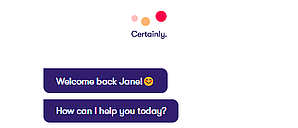
Your bot could even switch to a different language based on the visitor’s location. This helps create a sense of familiarity and strengthens the connection with the user.
Prioritize the readability of your messaging
Pay extra attention to the readability of your bot's content to help make conversations between your chatbot and customers as effortless as possible.
- Keep it simple
- Allow time for reading
- Include conversational markers
- Avoid repetition
- Emphasize appropriately
Keep it simple
Short messages are easy to read and understand, and they encourage more engagement. Write simple, to-the-point sentences to keep the conversation moving. 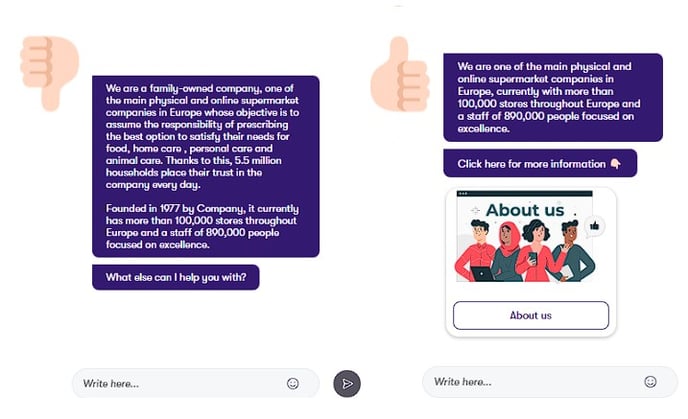
Don’t try to pack too much in at one time! Using links to sections on your website is a good way to provide valuable info while limiting the bot message content.
Allow time for reading
Let your customers read the bot’s responses by using message delays. This adds a more natural feel to the chat flow and helps bot visitors feel like they're part of a fluid conversation.
To add delays, use the timer feature within bot messages.
Include conversational markers
In a normal conversation, people use a range of cues that provide valuable context. We recommend incorporating the following in your chatbot messages:
- Discourse markers: Guide the user by making connections between conversation parts, such as indicating what comes next or referencing how it connects to what came before.
Examples: “Also”, “Ideally”, “Therefore”, “First”, “Otherwise”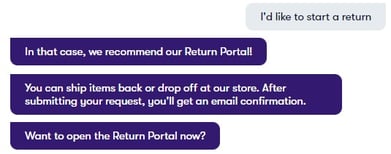
- Acknowledgments: Recognize that the bot has received the customer’s response.
Examples: “Got it”, “Sure”, “Thanks”, “Good choice”, “Checking on that now”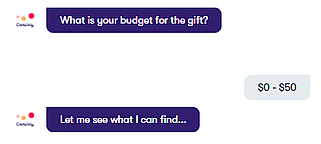
- Clear endpoints: Make sure chatbot visitors are aware when a conversation is over, and identify any next steps as needed.
Examples: “All done! You can exit the chat 😊”, “Glad I could help! Thanks for the chat👋”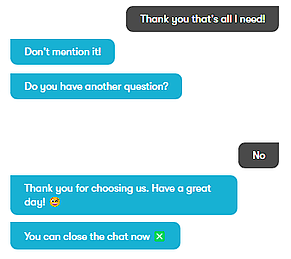
Avoid repetition
Write multiple versions of the same message for a smoother conversation, and don’t use the same version twice in a row. Consider the various scenarios that will lead to this response..jpg?width=688&name=variations%20(1).jpg)
Learn how to use the Variation feature.
Emphasize appropriately
Avoid using fully CAPITALIZED words to provide emphasis. Instead, use bold and italic text to highlight important chat details. Just remember to do so sparingly; otherwise, it loses its effect!
Ensure intuitive navigation
The ideal chatbot is helpful from the beginning, with well-planned flows and options catering to the users at every step.
Start off right
Set up clear paths that provide obvious value to the customer. Include starting flows throughout the entire conversation to guide users down specific paths, spark their interest, and point out different choices based on their expressed interests.
In the following examples from our Basic Ecommerce Bot Template, the chatbot visitor is presented with options that become more focused as the user further identifies their needs.
Consider the next step
Always offer a next step, an alternative, or even the option to go back to ensure the conversation never dead ends. This could be:
- presenting new menu items that seem relevant,
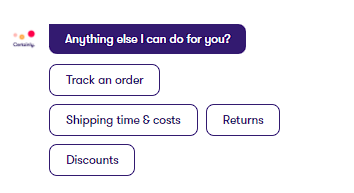
- requesting feedback on the bot’s ability to help the customer,
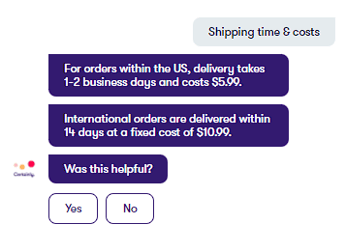
- preparing a fallback for cases when the bot doesn’t understand,
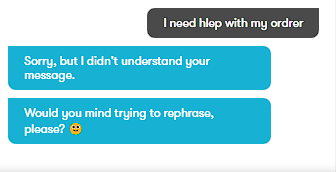
- or providing a follow-up alternative when no human agent is available upon request.

Be proactive
Have the bot take the initiative in the conversation with proactive support.
- Pop-up messages can help you attract users to a conversation or help them when you think they’ll most need it.
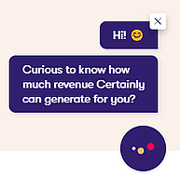
- Use questions with Suggested Replies to obtain more information from the customer, qualify it better, and help users stay on the right path.

- Consider adding a persistent menu to get your visitors back on track from any point in the conversation.
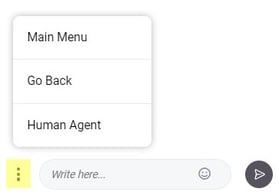
Evaluate and improve performance
As a bot-builder, you’ve worked hard to create a bot that provides value! Over time, you’ll want to monitor the bot’s performance and conduct regular maintenance to maximize your return.
Establish an evaluation procedure
Reviewing your bot's conversations with visitors will help you locate potential areas of improvement. We recommend using the Message Insights Report to identify chats where the bot doesn’t connect with your users, understand why, and take action.
Make comparisons
Compare your bot to both itself and competitors.
- Return to the role and goals you established for your chatbot at the beginning of the project. Has anything gotten lost over time?
- Gain a better understanding of how your bot is performing with our Traffic Report. What changes can be made to better serve your customers?
- Research what others in your field are doing. How can your chatbot be refined to outperform the competition?
Remain vigilant, as bots are still a relatively new technology.
Optimize and improve your chatbot
Use the information you’ve gathered from your evaluations and comparisons to keep improving your chatbot after every conversation. Constantly assessing the bot’s performance will enable you to optimize step by step, add new features, or enhance those you’ve already built.
Remember that nothing is perfect, and everything is subject to improvement!
Need help interpreting your data? Have ideas for optimization yet are unsure about the implementation? Just reach out to our Customer Success team – we’re always happy to help.
